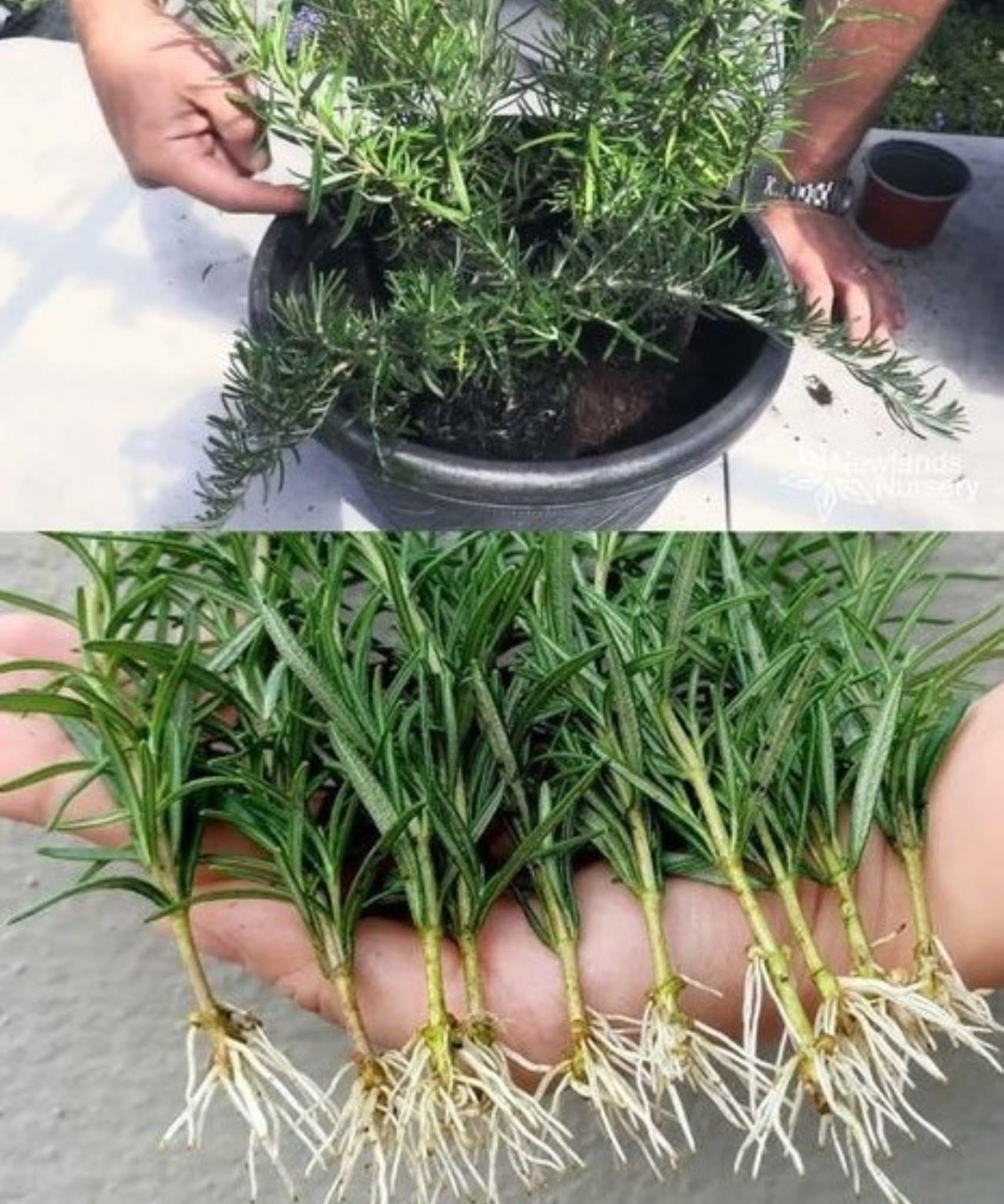Rosemary (Rosmarinus officinalis) is a fragrant herb that’s prized for its culinary and medicinal uses. It is relatively easy to grow, but getting it to grow fast, especially from a stem cutting, requires knowledge of the plant’s growth habits and the right environmental conditions. With the correct approach, you can propagate rosemary in no time and enjoy a flourishing herb garden. This guide outlines essential methods for growing rosemary quickly from stem cuttings, as well as expert insights into techniques like aeroponics, gene expression manipulation, and environmental control.
Understanding Rosemary’s Growth Cycle
Rosemary is a woody perennial herb that thrives in well-drained, slightly alkaline soils. It naturally prefers a Mediterranean climate with warm summers and mild winters, making it an ideal plant for regions with similar conditions. When growing rosemary from stem cuttings, it’s essential to consider its growth cycle and adapt propagation methods accordingly. Here’s an overview of the key growth stages:
- Dormancy: Rosemary typically undergoes a winter dormancy period where growth slows down. Cutting during this phase can sometimes result in slower rooting, so it’s best to take cuttings when the plant is actively growing, usually during the spring or early summer.
- Rooting: Rosemary cuttings begin to root quickly when exposed to the correct environmental conditions. The roots typically form in 2-3 weeks, though with optimal care and the use of rooting hormones, the process can be accelerated.
- Establishment: After the roots form, the young rosemary plant enters the establishment phase. During this stage, the plant begins to grow rapidly, with new shoots developing as it becomes acclimated to its new environment.
With a little patience and the right technique, your rosemary cuttings will thrive in a variety of growing setups. From traditional soil propagation to cutting-edge techniques like aeroponics and tissue culture, there are several methods that can encourage faster root growth and better establishment.
Step-by-Step Guide to Growing Rosemary from a Stem Cutting
1. Choose the Right Stem for Propagation
To ensure successful rosemary propagation, it’s crucial to select a healthy, non-flowering stem. Choose a stem that is firm and free of disease or pests. You should cut a stem that is 4-6 inches long, ideally from a mature rosemary plant. Avoid using stems that are too woody or too young, as they may have difficulty rooting.
2. Prepare the Cutting
- Remove Leaves: Strip the lower half of the cutting of its leaves, leaving only the top 1-2 inches with leaves attached. This ensures that the cutting doesn’t use too much energy to support the leaves while rooting.
- Optional: Use Rooting Hormone: For faster root development, you can dip the base of the cutting into a rooting hormone powder or gel. Rooting hormones contain auxins, which stimulate root formation and increase the likelihood of successful rooting.
3. Prepare the Growing Medium
For optimal root development, rosemary cuttings require a well-draining growing medium. You can propagate rosemary in soil, water, or aeroponic systems. The choice of medium will depend on your available space and resources.
- Soil: Use a well-draining soil mix, such as a combination of sand, perlite, and potting soil. Ensure that the soil is not too heavy, as rosemary prefers lighter soils with good aeration. A pot with drainage holes is crucial to prevent root rot.
- Water: Some gardeners prefer to propagate rosemary in water. If you choose this method, simply place the cutting in a glass of water, ensuring that only the bottom of the stem is submerged. Change the water every few days to keep it fresh.
4. Provide the Right Environmental Conditions
Rosemary cuttings thrive in warm, humid environments. To speed up the rooting process, it’s important to provide optimal environmental conditions.
- Temperature: Keep the temperature between 65-75°F (18-24°C). Rosemary cuttings are sensitive to extreme temperatures, and too much heat or cold can prevent rooting.
- Humidity: High humidity is essential for the cutting to retain moisture while the roots develop. You can create a humid environment by covering the cutting with a clear plastic bag or placing it under a humidity dome. If you’re using a propagation tray, ensure that it has a lid to maintain moisture.
5. Monitor Growth and Root Formation
In about 2-3 weeks, your rosemary cutting should develop roots. You can check for roots by gently tugging on the cutting—if there is resistance, the roots have formed. At this point, you can transplant the cutting into a larger container or directly into the garden, depending on your preference and climate.
Advanced Techniques to Accelerate Rosemary Growth
While the traditional method of propagating rosemary from cuttings works well, there are advanced techniques that can help speed up the process and improve success rates. These include techniques like gene expression modulation, aeroponic propagation, and specialized environmental control. By incorporating these techniques, you can maximize your rosemary harvest.
4.5 Gene Expression and Signal Transduction in Root Formation
Root formation in cuttings is regulated by a complex network of hormones and genes. Recent studies have revealed how specific genes and signaling pathways can influence rooting efficiency. Understanding these molecular mechanisms can help accelerate rooting and improve cutting success.
- WOX11/12 Activation: WUSCHEL-related homeobox (WOX) proteins, specifically WOX11 and WOX12, are involved in initiating the root founder cell program in response to auxin. When a cutting is wounded, these proteins are activated by auxin, promoting root formation at the base of the cutting.
- PIN Transporters: PIN proteins, such as PIN1 and PIN2, play a vital role in auxin transport. These proteins help to direct auxin flow toward the cutting base, promoting root development. Recent research indicates that light quality, such as far-red light pulses, can influence PIN protein localization, thus accelerating root primordia emergence.
- CLE Peptides: CLE peptides, which are secreted by developing root initials, help balance cell proliferation and differentiation. These peptides signal through CLV receptors, ensuring that roots form at an optimal rate without excessive callusing. CLE peptides act as key regulators of root development.
- Reactive Oxygen Species (ROS): Low-level ROS generated at cut sites enhance the expression of genes responsible for cell division. Studies have shown that mild exposure to ROS can increase root growth without causing oxidative damage to the plant tissues.
By optimizing light spectra, managing ROS levels, and using specific growth promoters, you can fine-tune the genetic and biochemical pathways that regulate root formation in rosemary cuttings.
5.5 Aeroponic Propagation Method
Aeroponics is a modern propagation technique that provides cuttings with direct access to high oxygen levels and nutrient mist. This method dramatically reduces rooting time and results in stronger, healthier roots. Here’s how to propagate rosemary using aeroponics:
- Setup: Mount your cuttings in foam collars above a mist chamber filled with a nutrient mist. This mist should have a low electrical conductivity (EC) of about 0.2 dS/m and a pH of 6.0.
- Misting Cycle: Program the misting system to pulse for 5 seconds every 5 minutes. This ensures that the stem bases are constantly receiving moisture without waterlogging.
- Environmental Control: Maintain a temperature of 23–26°C and a relative humidity (RH) of 70–80%. This balances transpiration and ensures that the cuttings can take up nutrients efficiently.
- Monitoring: Inspect your cuttings daily for root nubs. In around 8–10 days, when the roots are 2-3 cm long, transfer the cuttings to a substrate or directly into the soil.
Aeroponics has proven to be one of the most efficient methods for rosemary propagation, especially for large-scale growers.
6.11 Specialty Case Study I: Alpine Zone Trials
An interesting case study conducted in the Swiss Alps at an elevation of 2,000 meters tested rosemary propagation in extreme environmental conditions. The results were impressive.
- Scenario: Rosemary cuttings were propagated in perlite under double-glazed cold frames with heat mats set to 18°C for nighttime temperatures.
- Results: Within six weeks, 85% of the cuttings had rooted, reaching 3 cm in root length. The cold-hardened plants successfully survived the winter at temperatures as low as –5°C without any losses. This trial demonstrated that rosemary can adapt to alpine climates if propagation conditions are optimized.
Conclusion: A Fast, Efficient Rosemary Harvest
Growing rosemary from stem cuttings is a rewarding experience that allows you to quickly expand your herb garden. Whether you are a novice gardener or an expert looking to maximize propagation speed, advanced techniques such as gene expression modulation, aeroponic propagation, and specialized environmental control can significantly enhance rooting and growth.
By understanding the biological processes behind root formation and applying modern propagation methods, you can grow rosemary faster and healthier than ever before. Whether you’re propagating in your home garden or on a commercial scale, these methods will provide you with an efficient, sustainable way to grow rosemary and enjoy its aromatic benefits year-round.




